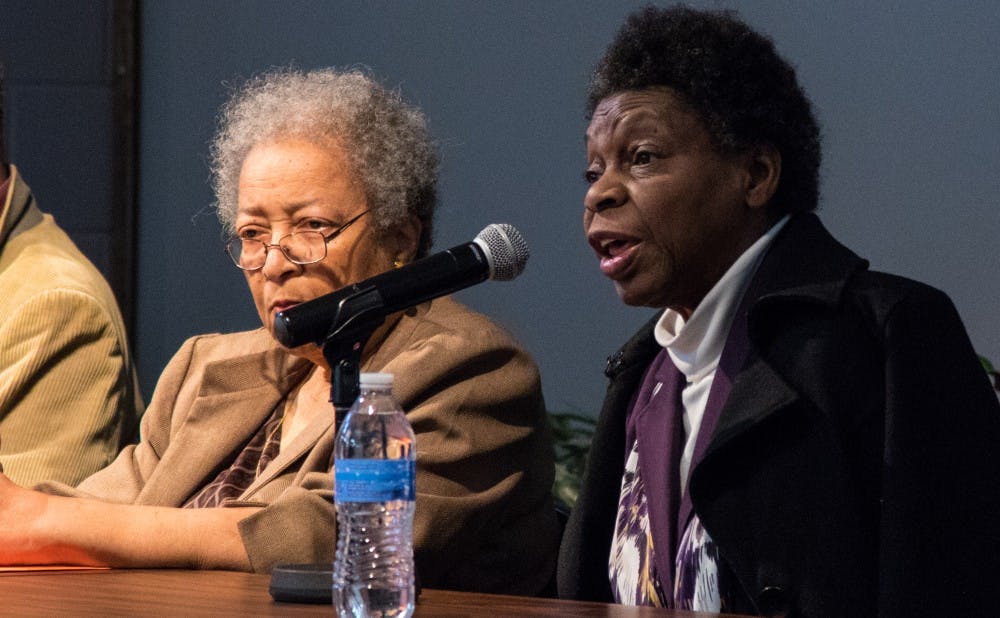In the early 1960s, the Student Nonviolent Coordinating Committee organized youth across the South in the fight for desegregation. On Saturday night at North Carolina Central University, six veterans of the movement came together in Durham to recount how they became involved with the movement.
Although the five activists—Faith Holsaert, Shirley Sherrod, Larry Rubin, Annette White and Janie Rambeau—came from a variety of backgrounds, their stories intertwined through their involvement with SNCC and their experiences in Albany, Georgia, the site of one of the toughest civil rights battles.
“[Albany was] one of the most important of the southern movements of the 1960s, and arguably the most ignored,” said Charlie Cobb, the event's facilitator and a board member for the SNCC Legacy Project who worked with SNCC in the Mississippi Delta. “All the people seated at this table have been important to the movement that emerged in southwest Georgia.”
The panel’s discussion was organized through a partnership between the SNCC Legacy Project, Duke University Libraries and the Center for Documentary Studies. It is the first of four sessions planned for 2017. Each discussion will focus on a particular topic—from Saturday night’s panel on southwestern Georgia to a future talk on SNCC’s international connections.
Karlyn Forner, the SNCC digital gateway project manager for Duke Libraries, explained that the former SNCC members' discussions will be included on a website that aims to share the organization's history.
“It’s trying to tell the story of the movement from the inside-out. Part of the premise is that the movement’s history has been told by historians and scholars, but not necessarily the people themselves who created the history,” Forner said. “So it’s really about trying to tell the history of the movement that the participants recognize and know.”
The history of SNCC began not far from NCCU on the campus of Shaw University in Raleigh. All of the veterans, however, had their own stories to share about how they became involved with the movement.
Janie Rambeau, a leader of the movement at Albany State College who was expelled because of her involvement in the movement, said that she cannot recall exactly when she became involved because she always considered herself part of it.
Rambeau grew up hearing her parents’ stories about discrimination and activism but began to see it more “outright” for herself when she was in high school—water fountains were segregated and labeled with signs, and the “colored” bathroom was dirtier. She was arrested while singing “We Shall Overcome” on a rainy December morning.
Annette White, who lost her title of Miss Albany State College due to protesting, similarly cited her early beginnings in the movement. She said that she was delivered by the only black, female doctor in Southwest Georgia in August 1939.
“That’s when it started,” she said. “I was in a totally segregated city on the south side of town, where black people lived. Everything that went on in that city affected me in some way. As I grew, my parents explained what being in a segregated city meant. My father wanted me to know what was out there so I could survive in that type of society.”
Faith Holsaert came to Albany from New York City where she first became involved in SNCC. When SNCC organizers approached her about going down South in the summer of 1962, she initially said no but then tragic events in Georgia changed her mind.
"At the end of that summer three churches were burned in southwest Georgia," she said. "For whatever reason, that really lit my fuse."
Larry Rubin, who is a Jewish veteran of the movement along with Holsaert, said that unlike other white northerners who ventured South, he was not shocked that people trying to register to vote were beaten up and fire-hosed.
“I know this is hard to believe,” he said with sarcasm, “but at that time this country was run by white, racist, white-supremacists. The reason it was is because a lot of their constituents were not able to exercise their right to vote.”
Rubin cited his Jewish heritage as one of the reasons that he felt he “had no choice” but to become part of the movement, leading him to move to southwest Georgia to join the efforts.
“I learned that part of my job was to be white in this movement,” he said. “To show people that blacks and whites can work together and that whites do not have to be in charge.”
Shirley Sherrod was born on a farm in “bad Baker County.” Her father died after being shot by a neighboring white farmer following a dispute over cows when she was 17. She said the night he died she made the decision to stay in the South and devote her life to making a difference. Sherrod joined SNCC a few years later.
Sheerod stressed that despite the passage of time, the need for activism has not ended.
“I’m still in that mode. I can’t separate the work after 52 years because it didn’t end,” she said. “The need for it is greater now, or almost as great now, as it was it back then. We need young people.”
Get The Chronicle straight to your inbox
Signup for our weekly newsletter. Cancel at any time.
Bre is a senior political science major from South Carolina, and she is the current video editor, special projects editor and recruitment chair for The Chronicle. She is also an associate photography editor and an investigations editor. Previously, she was the editor-in-chief and local and national news department head.
Twitter: @brebradham
Email: breanna.bradham@duke.edu

